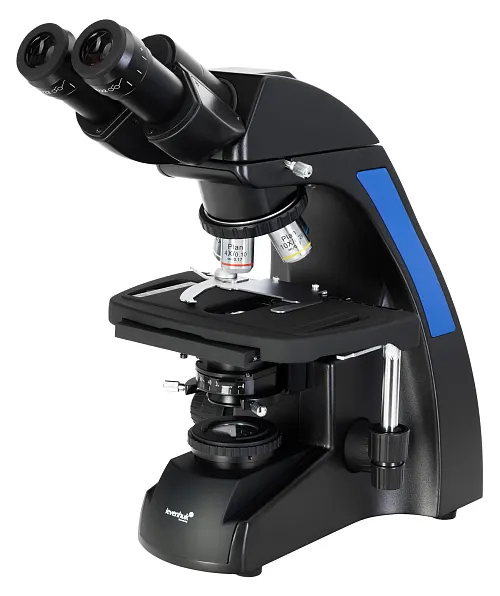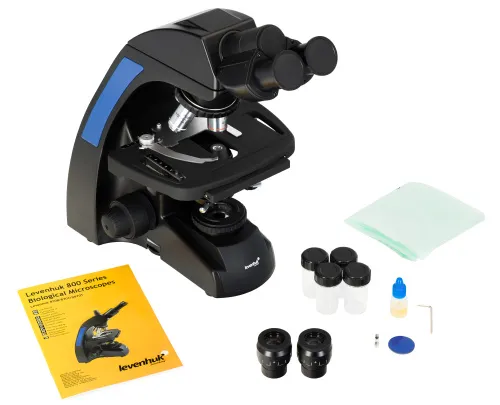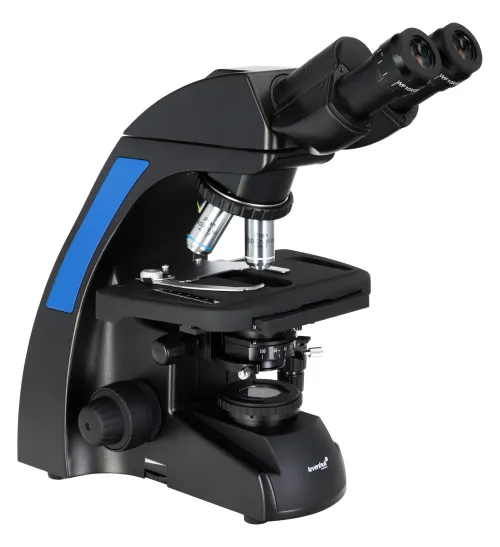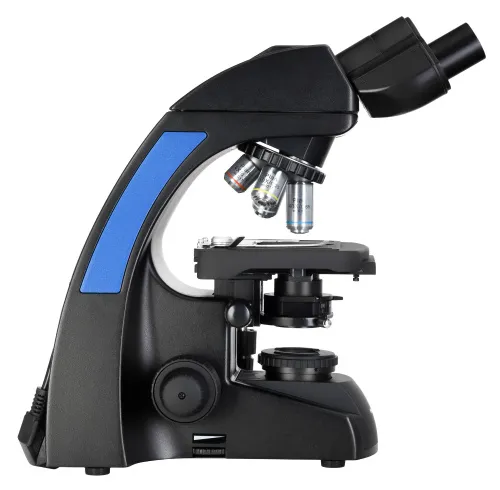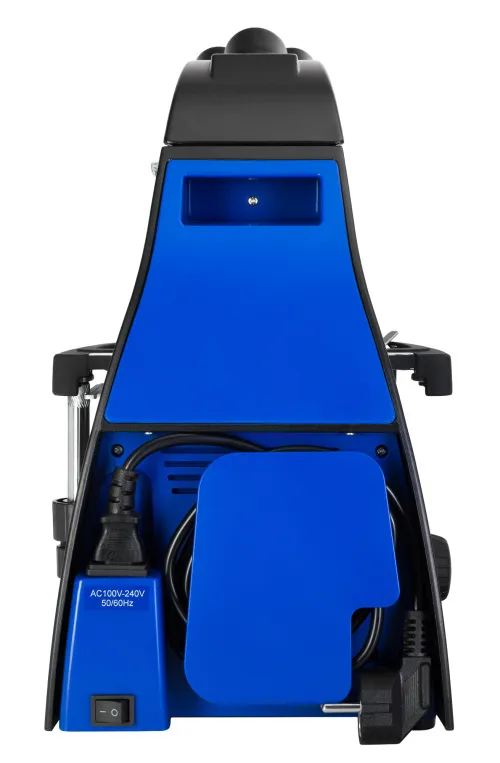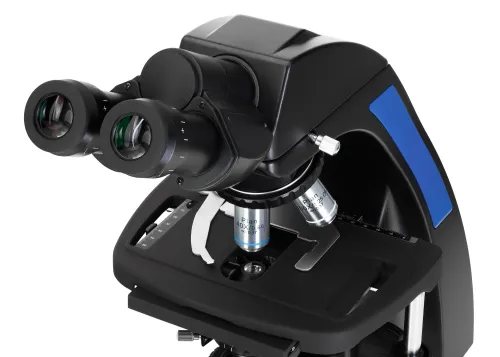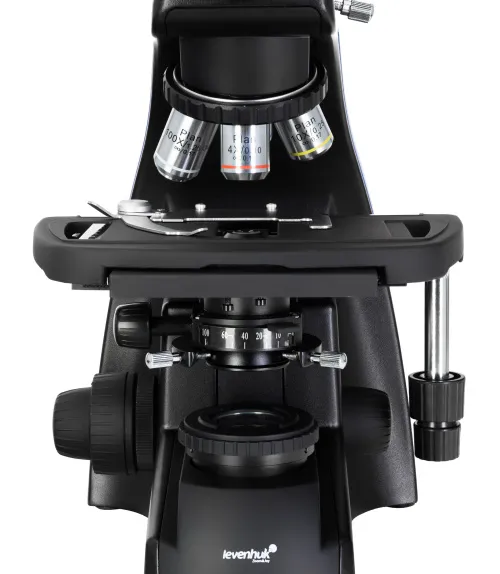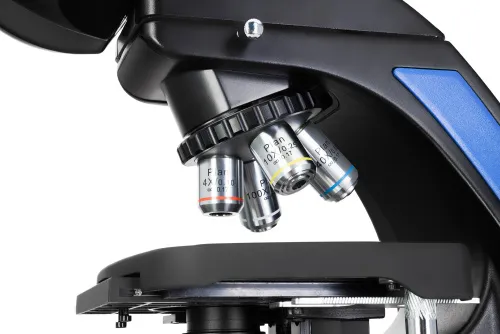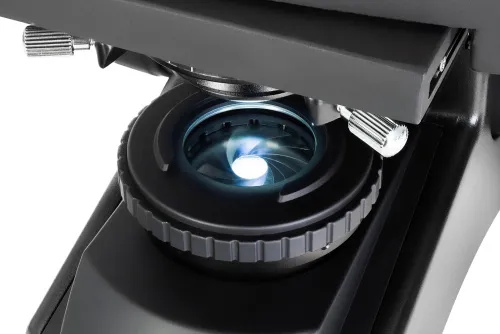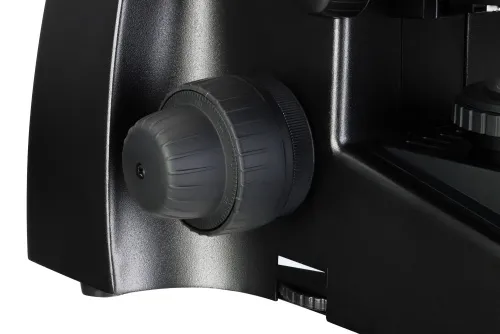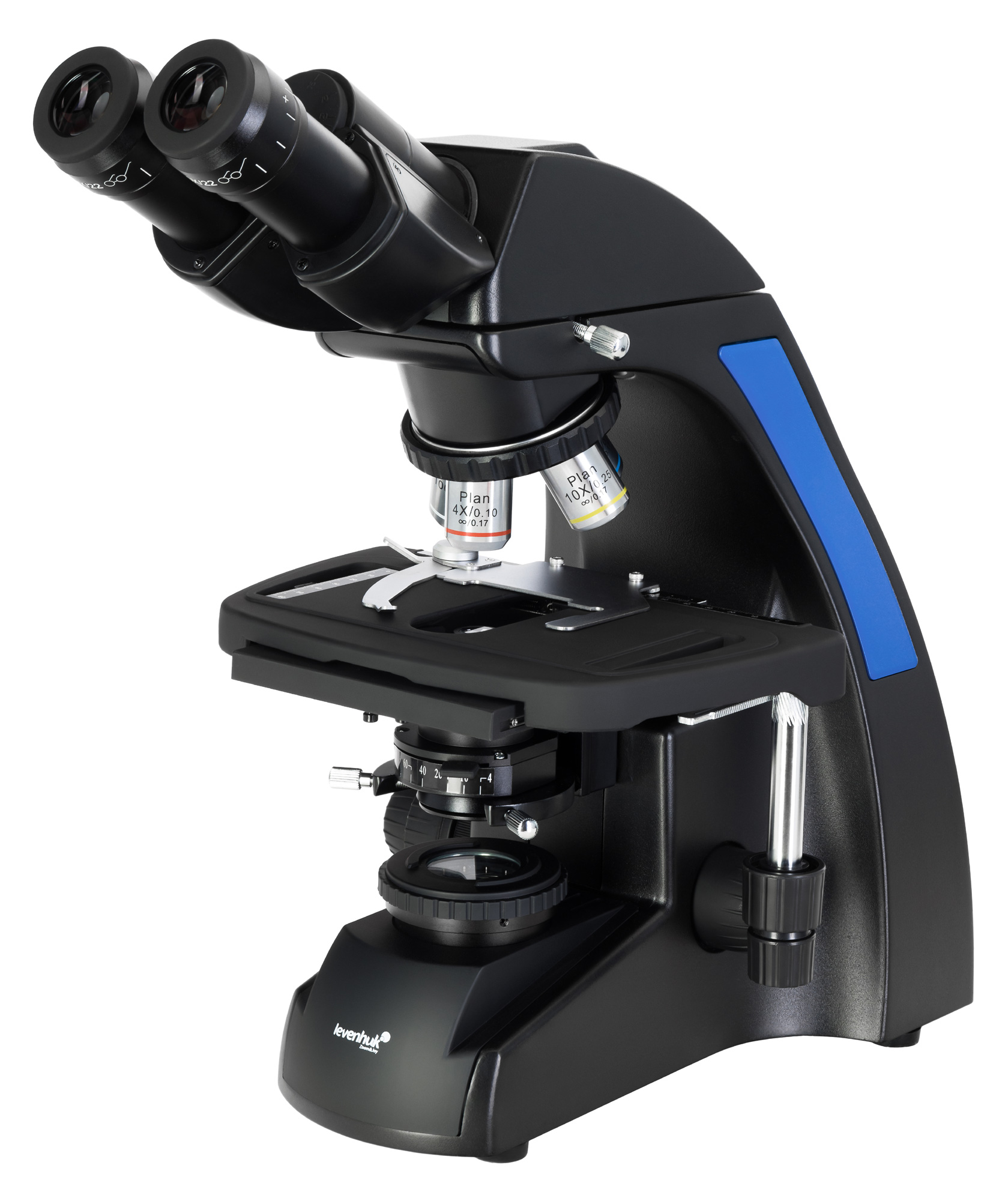Levenhuk 850B Biological Binocular Microscope
Magnification: 40–1000x. Infinity plan achromatic objectives, light source – LED 3W, stage with two specimen holders, Köhler illumination
| Product ID | 24611 |
| Brand | Levenhuk, Inc., USA |
| Warranty | lifetime |
| EAN | 5905555004464 |
| Package size (LxWxH) | 52x39x32 cm |
| Shipping Weight | 8.9 kg |
The Levenhuk 850B is a binocular biological microscope with plan achromatic optics for brightfield observations in transmitted light. It is used in various types of medical centers for urological, dermatological, biological, biochemical, anatomopathological, cytological, and general clinical laboratory research.
The microscope is equipped with a 360º rotatable binocular head with a 30º inclination angle and a 4-objective revolving nosepiece. The revolving nosepiece with objectives is oriented toward the interior – the user can see the objective inserted into the optical path, and the space above the stage is free. The interpupillary distance is adjustable over a wide range. 10x eyepieces with a 22mm field of view are included in the set, which allows you to view a large area of the specimen.
The focusing of the microscope is adjusted by coarse and fine focusing knobs. The focusing knobs move the stage in the vertical plane and also move it horizontally along two mutually perpendicular axes. The stage does not have a positioning rack. The low positioned stage knob enhances the user experience. The specimen holder is designed for two samples. Thanks to the soft focusing adjustment and stage movement mechanism, it is moved smoothly and effortlessly.
The use of an LED light source increases the resolution of the microscope. The LED is mounted in the base, it is brightness-adjustable, and it lasts a long time before needing a replacement. The aperture and field diaphragms allow for the Köhler illumination method. The illuminator is powered by an AC power supply (220V power cord is included).
Key features:
- Binocular head, digital camera mounted in one of the eyepiece tubes
- Magnification range: 40–1000x, plan aromatic optics
- Abbe condenser, aperture and field diaphragms, Köhler illumination
- Stage without a positioning rack and with two specimen holders
- Coaxial coarse and fine focusing mechanism
- LED illumination (transmitted light) with brightness adjustment
- Retractable collector for easy LED replacement
- AC power supply
The kit includes:
- Microscope base, revolving nosepiece, condenser, stage, built-in transmitted light illuminator, and power supply
- Binocular head
- Plan achromatic objectives: 4x, 10x, 40xs, 100xs (oil)
- Eyepiece WF10x/22mm (2 pcs.)
- Blue filter
- Bottle of the immersion oil
- AC adapter
- Dust cover
- User manual and warranty card
Caution: Please refer to the specifications table for the correct mains voltage and never attempt to plug a 110V device into 220V outlet and vice versa without using a converter. Remember that mains voltage in the U.S. and Canada is 110V and 220–240V in most European countries.
Some things you can see under a microscope:





The photo shows slides from Levenhuk ready-made specimen kits.
The Levenhuk 850B microscope is compatible with Levenhuk digital cameras (not included). Levenhuk cameras are installed in the eyepiece tube instead of an eyepiece.
| Product ID | 24611 |
| Brand | Levenhuk, Inc., USA |
| Warranty | lifetime |
| EAN | 5905555004464 |
| Package size (LxWxH) | 52x39x32 cm |
| Shipping Weight | 8.9 kg |
| Type | biological, light/optical |
| Microscope head type | binocular |
| Optics material | optical glass |
| Head | 360 ° rotatable |
| Head inclination angle | 30 ° |
| Magnification, x | 40 — 1000 |
| Eyepiece tube diameter, mm | 30 |
| Eyepieces | WF10x/22mm (2 pcs.) |
| Revolving nosepiece | for 4 objectives |
| Interpupillary distance, mm | 48 — 75 |
| Stage, mm | 210x150 |
| Stage moving range, mm | 75/55 |
| Stage features | mechanical double-layer, two-axis mechanical stage, without a positioning rack, with specimen holders |
| Eyepiece diopter adjustment, diopters | ±5 |
| Condenser | N.A. 1.25 |
| Diaphragm | built-in aperture and field |
| Focus | coaxial, coarse (24mm) and fine (0.002mm) |
| Body | metal |
| Illumination | LED |
| Brightness adjustment | ✓ |
| Power supply | 110–220V |
| Light source type | 3W LED |
| Light filters | blue |
| User level | experienced users |
| Assembly and installation difficulty level | easy |
| Application | laboratory/medical |
| Illumination location | lower |
| Research method | bright field |
| Pouch/case/bag in set | dust cover |
We have gathered answers to the most frequently asked questions to help you sort things out
Find out why studying eyes under a microscope is entertaining; how insects’ and arachnids’ eyes differ and what the best way is to observe such an interesting specimen
Read this review to learn how to observe human hair, what different hair looks like under a microscope and what magnification is required for observations
Learn what a numerical aperture is and how to choose a suitable objective lens for your microscope here
Learn what a spider looks like under microscope, when the best time is to take photos of it, how to study it properly at magnification and more interesting facts about observing insects and arachnids
This review for beginner explorers of the micro world introduces you to the optical, illuminating and mechanical parts of a microscope and their functions
All about Levenhuk microscopes
Short article about Paramecium caudatum - a microorganism that is interesting to observe through any microscope
Thanks for your question!
The only option would be to purchase camera separately and install it into one of the eyepieces.
Thank you!
2. Immersion oil should be placed between the cover glass and the objective lens .
3. No, unfortunately, we do not have such a set in our range of products.
2. Yes, it's possible to conduct measurements by using digital camera.
2. Yes, you can attach a camera to the Levenhuk 850B Biological Binocular Microscope.
2. Yes, there is only lower lighting. Yes, theoretically it's possible.
3. Yes, it's possible, direct your attention to these models: https://eu.levenhuk.com/catalogue/accessories/microscope-accessories/microscope-digital-cameras/ . The best choice will be a trinocular microscope. Unfortunately, adapters are not available at the moment.
6. This model currently comes with 3 filters (blue, green, orange)
7. The dust cover is included in the kit.
2. "PLAN" mark at the end of the line means that all objectives are plan-achromats.
3. We recommend Levenhuk digital cameras for microscopes: https://eu.levenhuk.com/catalogue/accessories/microscope-accessories/microscope-digital-cameras/ .
4. The increase is calculated according to the fact that the camera itself has 10x magnification.
2. Levenhuk M300 BASE Digital Camera. https://eu.levenhuk.com/catalogue/accessories/microscope-accessories/microscope-digital-cameras/levenhuk-m300-base-digital-camera/
3. We don't have these cameras in our assortment.
2. The diopter adjustment is done by rotating the right eyepiece. One eye adapts to another, it's enough to adjust only one eye. 3. The condenser is situated under the stage, there are objects that should be studied only in dark field. 4. Filters should be inserted also under the stage, there is a special recess for installation. Different studies require different contrast. Can you clarify what exactly are you going to study?
2. Thin and transparent.
3. Unfortunately, we don't sell these filters separately.
3 filters (yellow, green and blue) are included in the kit.

